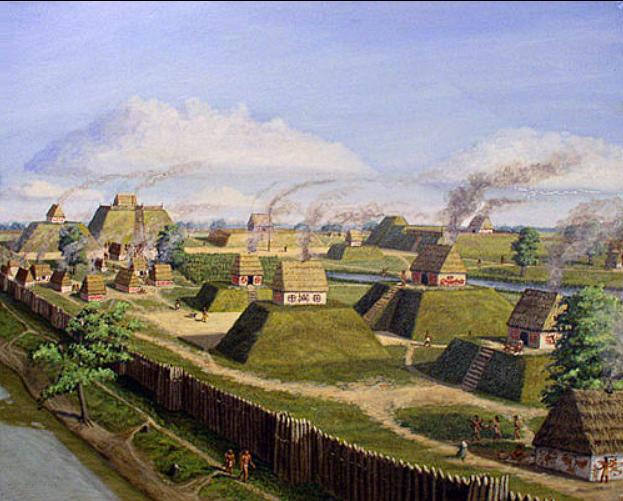Introduction: A Forgotten Civilization
Centuries before European explorers set foot in North America, a powerful civilization flourished along the Mississippi River. Known as the Mississippian culture, this society built massive earthen mounds, developed advanced urban centers, and influenced vast regions of pre-Columbian America. At its peak, their great city of Cahokia rivaled the size of medieval London, yet today, few people even know of their existence. Who were these master builders, and what led to their mysterious decline?

The Rise of the Mississippian Culture
Urban Centers and Monumental Mounds
The Mississippians were remarkable city builders, with Cahokia in present-day Illinois standing as their most impressive urban center. The city covered over 6 square miles and housed tens of thousands of residents. At its heart stood Monks Mound, a massive earthen structure towering over 100 feet high, serving as a central hub for religious and political activities.
A Thriving Trade Network
This civilization was not isolated; they maintained extensive trade networks stretching across North America. Archaeologists have uncovered artifacts made of shells from the Gulf Coast, copper from the Great Lakes, and obsidian from the Rocky Mountains, indicating a vibrant exchange of goods and cultural ideas.
Advanced Agricultural Practices
Corn, beans, and squash formed the backbone of Mississippian agriculture. Their mastery of farming techniques allowed them to sustain large populations and build complex societies. The surplus of food enabled the rise of specialized labor, religious elites, and ruling classes.
The Life and Culture of the Mississippians
Religious and Ceremonial Practices
The Mississippians had a rich spiritual life centered around their mounds, which often served as platforms for temples and elite residences. They practiced elaborate burial ceremonies, used effigy mounds for religious purposes, and aligned their constructions with astronomical events.
Warfare and Social Structure
Unlike the peaceful image some might imagine, Mississippian society was not without conflict. Archaeological evidence, such as palisaded fortifications and weapons, suggests they engaged in warfare. Chiefs and rulers maintained power through military strength, religious authority, and economic control.
Art and Symbolism
Mississippian artisans created intricate pottery, engraved shell ornaments, and copper plates depicting their gods and myths. Their iconography, often featuring birds, serpents, and warriors, provides insights into their beliefs and daily lives.
The Mysterious Decline
Environmental Factors
One of the leading theories behind their decline involves climate change. Prolonged droughts and shifting weather patterns may have disrupted their agriculture, leading to food shortages and social unrest.
Resource Depletion
With a growing population, the Mississippians may have overexploited their natural resources. Deforestation for building materials and farmland could have led to soil erosion, making it difficult to sustain large cities.
Internal Conflicts and European Contact
While the civilization declined before significant European contact, some historians suggest that diseases introduced by early explorers may have contributed to their downfall. Additionally, internal conflicts and power struggles could have weakened their societal structures.
The Enduring Legacy
Modern Descendants
The Mississippian culture did not vanish completely. Many Indigenous tribes, including the Cherokee and Creek, are believed to be descendants of this ancient civilization, carrying forward some of their traditions and knowledge.
Archaeological Discoveries
Excavations at Cahokia and other sites continue to reveal fascinating details about their way of life. These discoveries challenge old assumptions about pre-Columbian North America and highlight the complexity of its civilizations.
Preserving the Mounds
Today, many of the Mississippian mounds are protected as historical sites. Cahokia Mounds State Historic Site is a UNESCO World Heritage site, attracting visitors and scholars eager to learn about this lost civilization.
Conclusion: What Can We Learn?
The Mississippians built one of the most advanced societies of their time, yet they eventually faded into history. Their story reminds us of the fragility of civilizations and the importance of sustainable practices. What other secrets lie buried beneath the earth, waiting to be uncovered?
Let’s keep exploring the past—one mound at a time.

CÁC TIN KHÁC
Mary Walton: The Forgotten Inventor Who Helped Clean Up America’s Cities
Tomb of Queen Nefertari in the Valley of the Queens, Egypt
Discover the Hypostyle Hall of the Temple of Hathor at Dendera
Venus de Losange: Unveiling the Mystery of a 20,000-Year-Old Paleolithic Icon